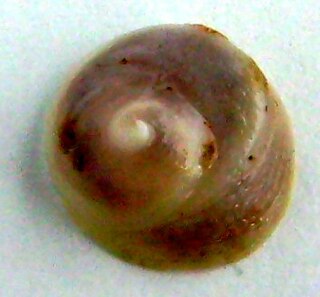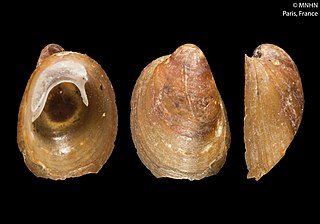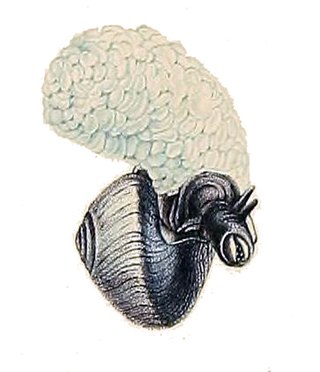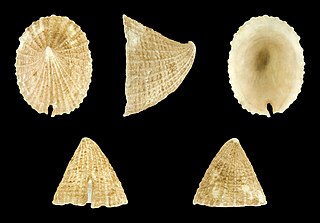
Crepidula fornicata is a species of medium-sized sea snail, a marine gastropod mollusc in the family Calyptraeidae, the slipper snails and cup and saucer snails. It has many common names, including common slipper shell, common Atlantic slippersnail, boat shell, quarterdeck shell, fornicating slipper snail, Atlantic slipper limpet and it is in Britain as the "common slipper limpet".

The Calyptraeidae are a family of small to medium-sized marine prosobranch gastropods.

Sigapatella novaezelandiae, common name the circular slipper limpet, is a species of medium-sized sea snail, a marine gastropod molluscs in the family Calyptraeidae.

Crepidula, commonly known as the slipper snails, slipper limpets, or slipper shells, is a genus of sea snails, marine gastropod mollusks in the family Calyptraeidae. This family includes the slipper snails (Crepidula), hat snails (Calyptraea), spiny slipper snails (Bostrycapulus), and cup-and-saucer snails (Crucibulum) as well as Crepipatella, Siphopatella, Grandicrepidula, and Maoricrypta.

Patella vulgata, common name the common limpet or common European limpet is a species of sea snail. It is a typical true limpet; a marine gastropod mollusc in the family Patellidae, with gills. This species occurs in the waters of Western Europe.

Janthina janthina is a species of holoplanktonic sea snail, a marine gastropod mollusk in the family Epitoniidae. Its common names include violet sea-snail, common violet snail, large violet snail and purple storm snail.

Emarginula fissura, the common slit limpet, is a species of sea snail, a marine gastropod mollusk in the family Fissurellidae, the keyhole limpets.
Bostrycapulus heteropoma is a species of sea snail, a marine gastropod mollusk in the family Calyptraeidae, the slipper snails or slipper limpets, cup-and-saucer snails, and Chinese hat snails.
Calyptraea africana is a species of sea snail, a marine gastropod mollusk in the family Calyptraeidae, the slipper snails or slipper limpets, cup-and-saucer snails, and Chinese hat snails.
Calyptraea centralis is a species of sea snail, a marine gastropod mollusk in the family Calyptraeidae, the slipper snails or slipper limpets, cup-and-saucer snails, and Chinese hat snails.

Calyptraea helicoidea is a species of sea snail, a marine gastropod mollusk in the family Calyptraeidae, the slipper snails or slipper limpets, cup-and-saucer snails, and Chinese hat snails.
Calyptraea inexpectata is a species of sea snail, a marine gastropod mollusk in the family Calyptraeidae, the slipper snails or slipper limpets, cup-and-saucer snails, and Chinese hat snails.
Crepidula badisparsa is a species of sea snail, a marine gastropod mollusk in the family Calyptraeidae, the slipper snails or slipper limpets, cup-and-saucer snails, and Chinese hat snails.
Crepidula depressa is a species of sea snail, a marine gastropod mollusk in the family Calyptraeidae, the slipper snails or slipper limpets, cup-and-saucer snails, and hat snails.

Crepidula porcellana, common name the slipper limpet, is a species of sea snail, a marine gastropod mollusk in the family Calyptraeidae, the slipper snails or slipper limpets, cup-and-saucer snails, and Chinese hat snails.

Calyptraea, commonly known as the Chinese hat snails is a genus of sea snails, marine gastropod mollusks in the family Calyptraeidae, a family which contains the slipper snails or slipper limpets, cup-and-saucer snails, and Chinese hat snails.

Trochita is a genus of sea snails, marine gastropod mollusks in the family Calyptraeidae, the slipper snails or slipper limpets, cup-and-saucer snails, and Chinese hat snails.

Tibia fusus, common name Spindle tibia or Shinbone Tibia Gastropod, is a species of large sea snail, a marine gastropod mollusk in the family Strombidae, the true conchs.

Distorsio reticularis, common name reticulate distorsio, is a species of medium-sized sea snail, a marine gastropod mollusk in the family Personidae, the Distortio snails.














